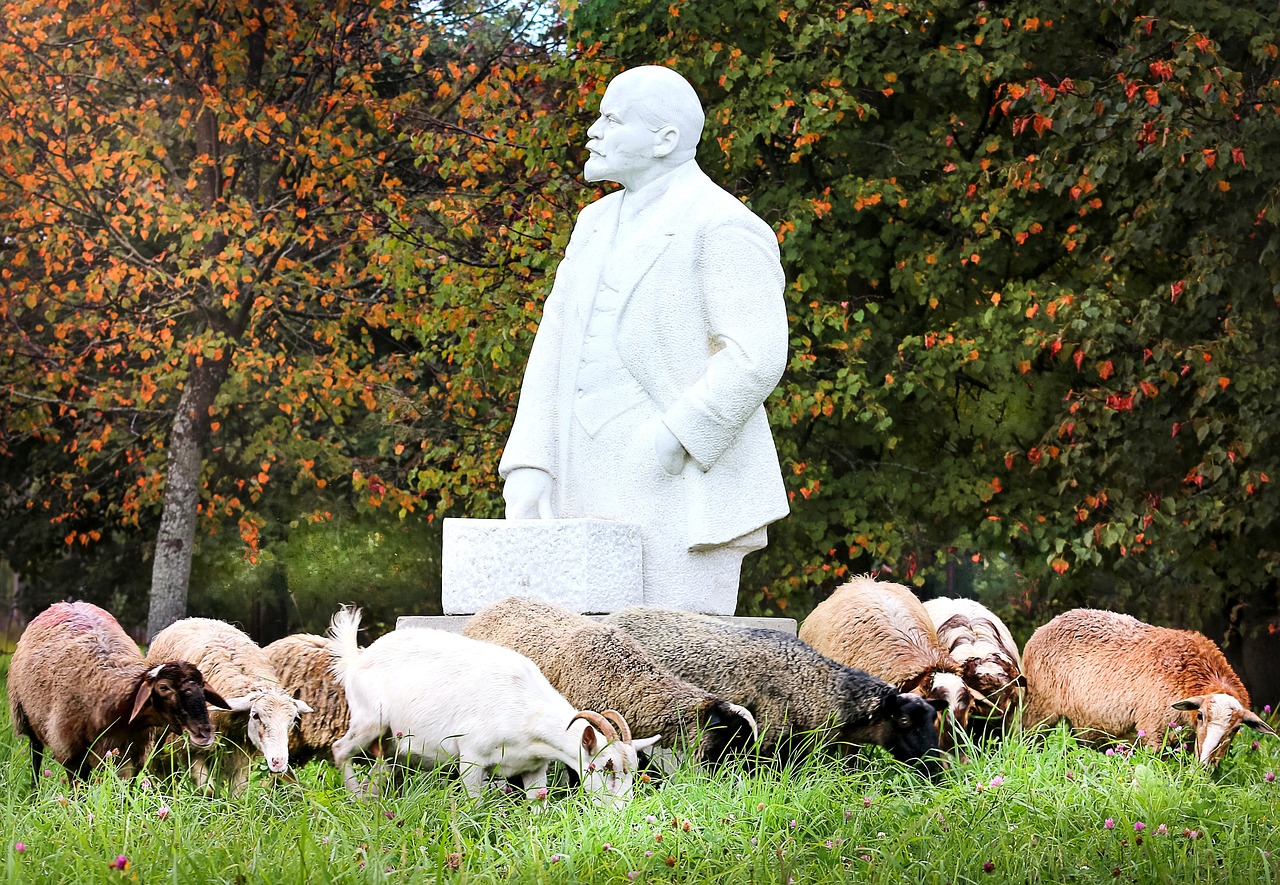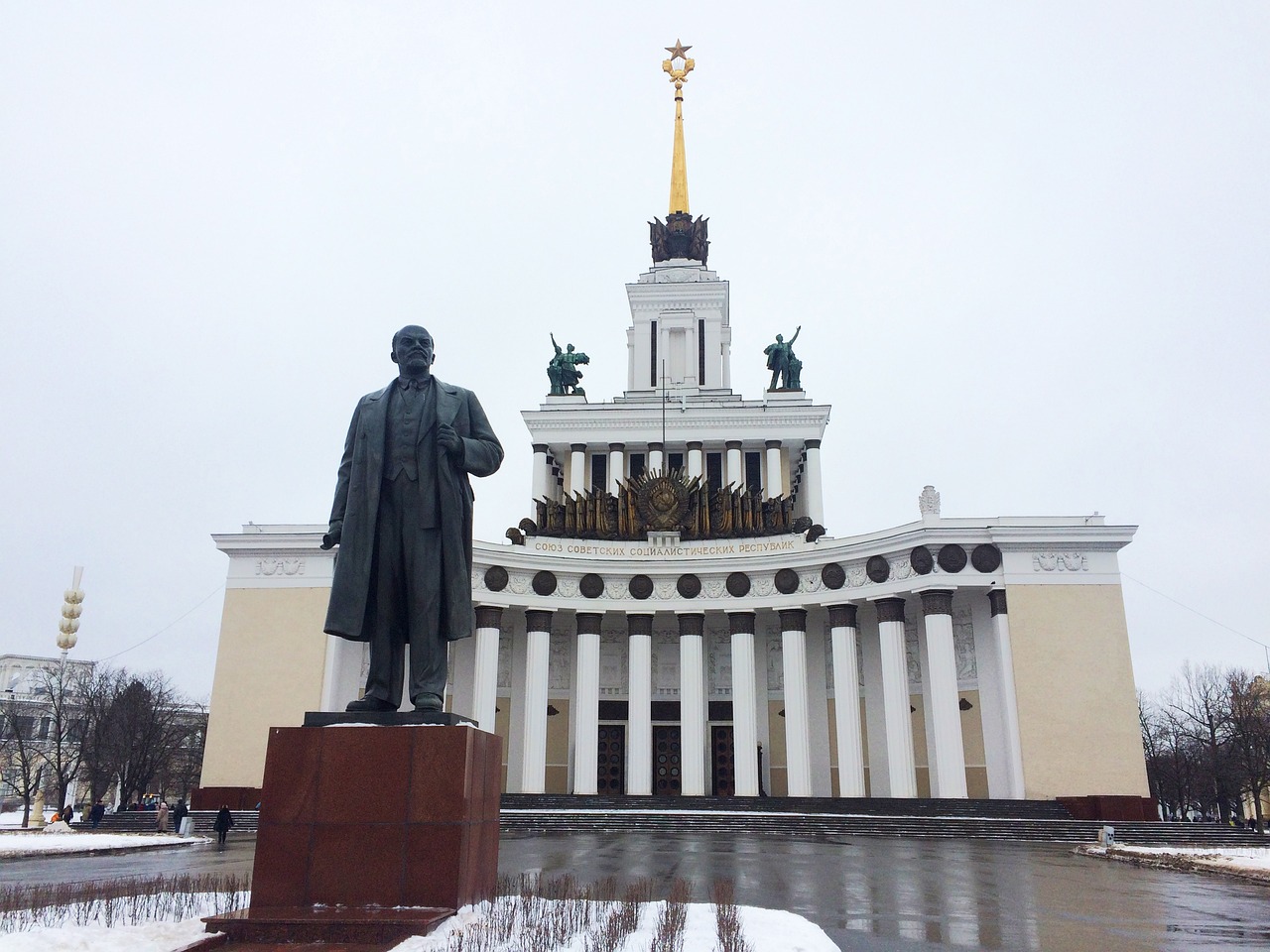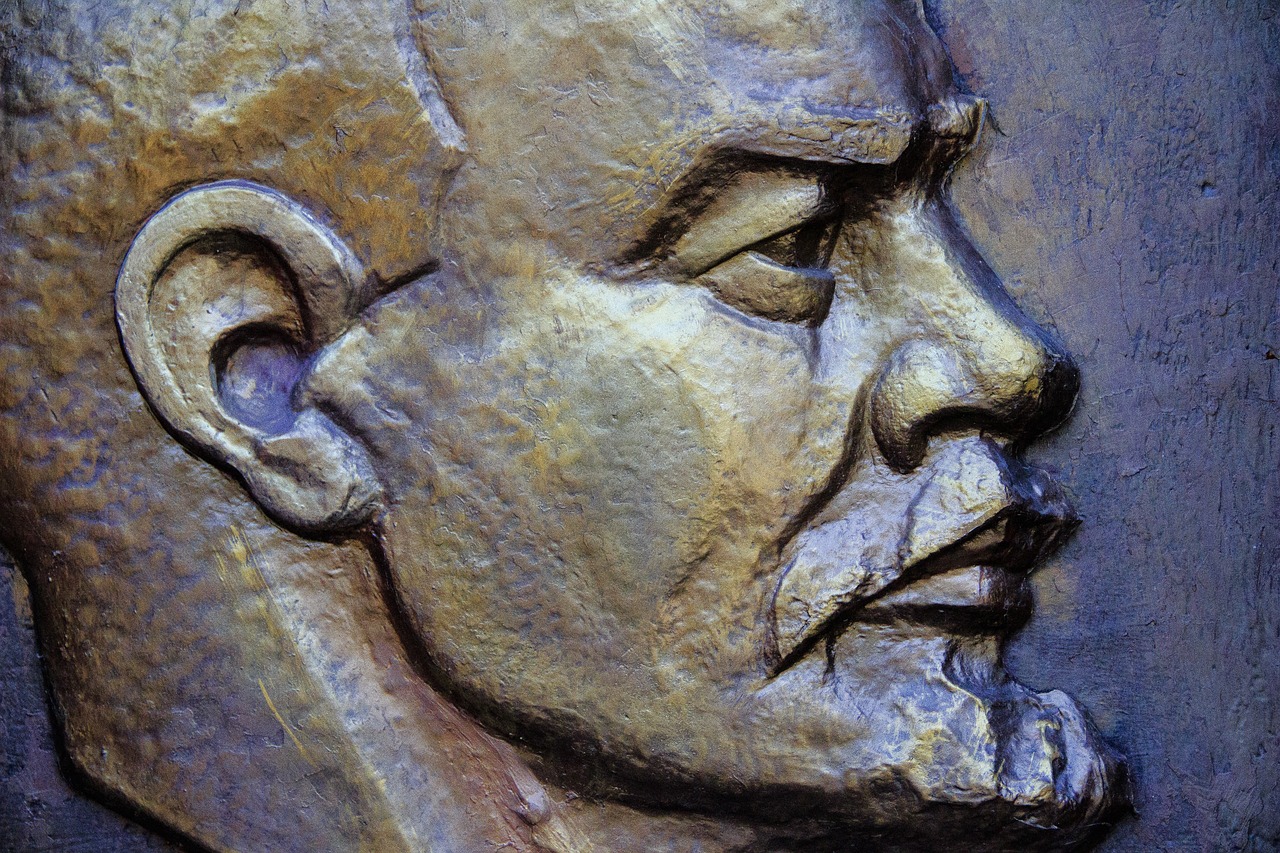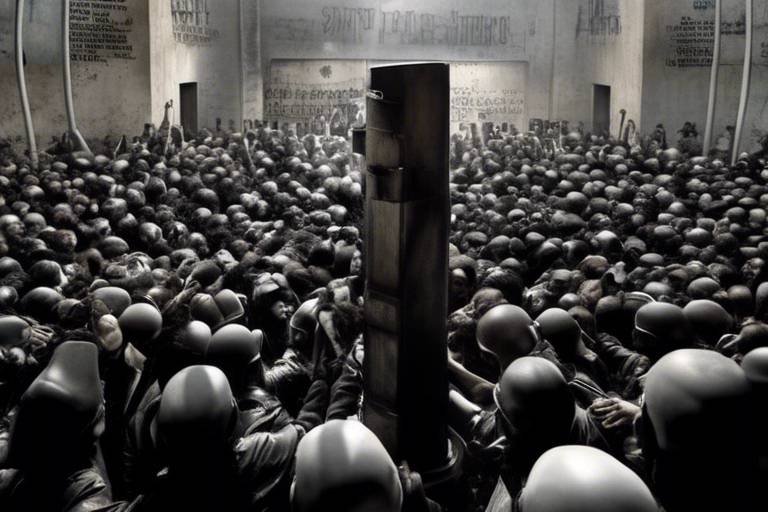Lenin’s Philosophy: How it Shaped Soviet Politics
When we delve into the intricate web of Soviet politics, one cannot overlook the towering figure of Vladimir Lenin. His philosophical ideas didn't merely float in the ether; they were the very lifeblood of the revolutionary movement that transformed Russia in the early 20th century. Imagine a world where the common people, long oppressed, suddenly found their voice and power. Lenin's philosophy was the megaphone that amplified their cries for change and justice. This article explores how Lenin's thoughts and beliefs laid the groundwork for a new political landscape, one that would echo through the corridors of history and shape the future of nations.
Lenin's philosophy was not just a collection of abstract ideas; it was a roadmap for action. His insights into class struggle, the role of the party, and the necessity of revolution were pivotal. They provided a framework that motivated millions to rally around a common cause. But what exactly were the philosophical underpinnings of Leninism, and how did they manifest in the political structures of the Soviet Union? This article aims to dissect these elements, revealing the profound impact of Lenin's ideas on governance and ideology.
To fully appreciate Lenin's influence, we must first understand the historical context in which he operated. Russia was a cauldron of discontent, simmering with the frustrations of the working class and the peasantry. The socio-political landscape was fraught with challenges, from widespread poverty to an autocratic regime that seemed impervious to reform. In this tumultuous environment, Lenin's philosophy emerged as a beacon of hope. His call for a revolutionary vanguard and the establishment of a socialist state resonated deeply with those yearning for change. Lenin didn't just theorize; he acted, leading the charge that would ultimately reshape the nation.
As we journey through the key tenets of Leninism, we encounter concepts that are as revolutionary as they are practical. The notion of the vanguard party stands out prominently. Lenin argued that a politically conscious elite must guide the working class, steering them toward the realization of socialism. This wasn't just a theoretical construct; it was a call to arms. The party, as envisioned by Lenin, was not merely a political organization but a disciplined force capable of mobilizing the masses against the bourgeoisie. The implications of this idea were profound, leading to a highly centralized and hierarchical party structure that would dominate Soviet governance for decades.
In addition to the vanguard party, the principle of democratic centralism played a crucial role in Lenin's philosophy. This concept promoted internal democracy within the party while maintaining a unified front to achieve revolutionary goals. It was a balancing act, ensuring that while diverse opinions could be aired, a cohesive strategy would prevail. This approach shaped not just the party's internal dynamics but also its relationship with the broader populace, establishing a framework for governance that emphasized both discipline and unity.
Lenin's philosophical contributions didn't just stop at theoretical frameworks; they directly influenced the establishment of the Soviet state. His ideas facilitated the transformation of Russia into a socialist state, leading to the creation of institutions that reflected his revolutionary vision. The policies implemented during this period, such as War Communism and the New Economic Policy, were manifestations of Lenin's ideology, each reflecting his stance on governance and economic management. These policies were not without controversy, but they were crucial in navigating the challenges of a fledgling socialist state.
Even today, the legacy of Lenin's philosophy continues to resonate. His ideas have influenced various socialist movements and political ideologies across the globe, shaping both historical and contemporary political landscapes. Leaders who followed in Lenin's footsteps, like Joseph Stalin, adapted and expanded upon his philosophies, using them to consolidate power and implement their own agendas. The ripple effect of Leninism can be seen in revolutionary movements worldwide, inspiring parties to adopt similar ideologies in their own contexts.
In conclusion, Lenin's philosophy was not just an abstract collection of ideas; it was a powerful catalyst for change that fundamentally altered the course of history. By understanding the key tenets of Leninism and their implications for Soviet governance, we gain insight into the complexities of political ideology and its real-world applications. Lenin's vision of a socialist state, driven by a committed vanguard party and democratic centralism, continues to spark debates and inspire movements even today.
- What is Leninism? Leninism is a political theory developed by Vladimir Lenin that emphasizes the role of a vanguard party in leading the working class to revolution and establishing a socialist state.
- How did Lenin's ideas influence Soviet governance? Lenin's ideas shaped the structure and policies of the Soviet state, leading to the establishment of a centralized party and significant economic policies like War Communism and the New Economic Policy.
- What is democratic centralism? Democratic centralism is a principle in Leninism that promotes internal democracy within the party while ensuring unity and discipline in pursuing revolutionary goals.
- What is the legacy of Lenin's philosophy? Lenin's philosophical contributions have influenced numerous socialist movements worldwide and continue to shape political ideologies today.

Historical Context of Lenin’s Philosophy
To truly grasp the essence of Lenin’s philosophy, it's essential to step back and examine the socio-political landscape of Russia in the late 19th and early 20th centuries. This period was marked by intense social stratification, economic turmoil, and political repression. The Russian Empire was a vast entity, but it was riddled with discontent among various classes, especially the working class and peasantry, who faced dire living conditions and oppressive governance.
During this time, the **industrial revolution** was beginning to take root, leading to the growth of cities and a burgeoning proletariat class. However, this growth was not without its challenges. Workers toiled under harsh conditions, often for meager wages, while the aristocracy and bourgeoisie thrived. The stark contrast between the wealthy elite and the impoverished masses created a fertile ground for revolutionary ideas to flourish. Lenin, influenced by Marxist theory, saw this disparity as a catalyst for change. He believed that the disillusionment of the working class could be harnessed to ignite a revolution.
Moreover, the political landscape was dominated by autocratic rule, with Tsar Nicholas II at the helm. His regime was marked by **censorship**, political repression, and a refusal to implement meaningful reforms. This environment stifled dissent and led to the formation of various revolutionary groups, including the Bolsheviks, which Lenin would later lead. The **Russo-Japanese War** (1904-1905) and the **1905 Revolution** further highlighted the weaknesses of the Tsarist regime, as military defeats and public unrest culminated in strikes and uprisings across the empire.
In this context, Lenin’s philosophy began to take shape. He argued for a radical approach to revolution, emphasizing the need for a **vanguard party** to lead the working class. This was a direct response to the failures of previous uprisings, which he believed lacked the necessary organization and ideological clarity. Lenin’s vision was not merely theoretical; it was a practical blueprint designed to mobilize the masses and seize power from the bourgeoisie.
To illustrate the historical context further, consider the following table that summarizes key events leading up to Lenin's rise:
| Year | Event | Significance |
|---|---|---|
| 1904-1905 | Russo-Japanese War | Exposed the weaknesses of the Tsarist regime and fueled discontent. |
| 1905 | 1905 Revolution | First major uprising against Tsarist autocracy, leading to limited reforms. |
| 1917 | February Revolution | Overthrew the Tsar, leading to the establishment of a provisional government. |
| 1917 | October Revolution | Bolsheviks, led by Lenin, seized power and established a socialist state. |
In summary, the historical context of Lenin’s philosophy is a tapestry woven from threads of social injustice, political repression, and the fervent desire for change. It was this backdrop that not only shaped Lenin's ideas but also propelled him into the forefront of a revolutionary movement that would alter the course of history. As we delve deeper into the key tenets of Leninism, we will see how these ideas were not just abstract concepts but practical strategies aimed at transforming society.

Key Tenets of Leninism
Leninism is not just a collection of ideas; it’s a profound political philosophy that reshaped the very fabric of Russian society and beyond. At its core, Leninism revolves around several key tenets that were meticulously crafted to address the unique socio-political challenges of early 20th-century Russia. These principles include the concept of the vanguard party, the practice of democratic centralism, and the establishment of the dictatorship of the proletariat. Each of these ideas played a crucial role in the formation and functioning of the Soviet state, and they continue to influence political thought to this day.
One of the most significant aspects of Leninism is the idea of the vanguard party. Lenin believed that a politically conscious elite was essential for leading the working class towards revolution and socialism. This wasn’t just a casual suggestion; it was a fundamental necessity in his eyes. He argued that the proletariat, while capable of achieving great things, needed guidance from a party that understood the intricacies of Marxist theory and the dynamics of class struggle. This elite group, or vanguard, would not only mobilize the masses but also act as a bulwark against the bourgeoisie, ensuring that the revolution remained on track.
But what does it mean to have a vanguard party? Essentially, it means that the party must be highly disciplined and organized. Lenin emphasized that the party should be structured in a way that allows for effective mobilization of the working class. This led to a highly centralized and hierarchical organization, which, while efficient in executing revolutionary goals, also raised questions about democracy and representation within the party itself.
Another cornerstone of Leninism is democratic centralism. This principle promotes a dual approach to governance within the party. On one hand, it encourages internal democracy where party members can discuss and debate policies. On the other hand, once a decision is made, all members are expected to uphold and implement that decision without dissent. This creates a sense of unity and discipline, but it also means that individual voices can be overshadowed by the party line. It's a balancing act that aims to maintain order while fostering participation, though it often leads to tensions about who gets to speak and whose voices are heard.
Finally, the dictatorship of the proletariat is a concept that encapsulates Lenin's vision of a transitional state. After the revolution, Lenin argued that the working class must seize control of the state apparatus to dismantle the existing capitalist structures. This dictatorship is not meant to be oppressive but rather a necessary phase to protect the revolution from counter-revolutionary forces. It’s a means to an end, aimed at establishing a classless society where the state eventually withers away. However, in practice, this concept often led to the concentration of power in the hands of a few, raising questions about the true nature of freedom and equality in a Leninist state.
In summary, the key tenets of Leninism—vanguard party, democratic centralism, and dictatorship of the proletariat—are interconnected elements that shaped Soviet governance and continue to influence political movements worldwide. Understanding these principles is crucial for anyone looking to grasp the complexities of Lenin's legacy and its implications for modern politics.

The Vanguard Party Concept
The concept of the vanguard party is one of the cornerstones of Lenin's philosophical framework, serving as a beacon for revolutionary action. At its core, the vanguard party is envisioned as a politically conscious elite group that leads the working class in its quest for socialism. Lenin believed that a revolution couldn't occur spontaneously; it required a dedicated and disciplined organization to guide the masses. Think of it as a ship navigating through stormy seas—without a skilled crew at the helm, the ship risks capsizing amidst the chaos of societal upheaval.
Lenin's emphasis on the vanguard party was not merely about leadership; it was about mobilization and education. He argued that the working class, while inherently revolutionary, often lacked the necessary political awareness to achieve its goals. Thus, the vanguard party's role was to enlighten the proletariat about their potential power and the means to achieve it. This educational aspect was crucial, as Lenin understood that a well-informed and organized working class could challenge the bourgeoisie effectively.
To illustrate the significance of the vanguard party, let’s break down its essential functions:
- Leadership: The party acts as a leader, directing the revolutionary efforts of the masses.
- Education: It educates the working class about their rights and the principles of socialism.
- Organization: The party organizes the proletariat into a cohesive force capable of challenging the existing power structures.
Lenin's vision mandated a highly centralized and hierarchical structure within the party. This was essential for maintaining discipline and unity, especially in the face of opposition. The party's leadership needed to be decisive, and this required a clear chain of command. However, this centralization also raised questions about internal democracy—how could the party remain representative of the working class while being so tightly controlled? This tension between authority and representation would continue to surface throughout Soviet history.
In practice, the vanguard party concept led to the establishment of a political apparatus that was both powerful and, at times, oppressive. The party's monopoly on political power meant that dissenting voices within the working class were often silenced, raising ethical concerns about the very democracy Lenin sought to promote. The implications of the vanguard party concept were profound, shaping not only the structure of the Bolshevik party but also the governance of the Soviet Union for decades to come.
In summary, the vanguard party was more than just a theoretical construct; it was a practical necessity in Lenin's eyes. It embodied his belief that revolutionary change required not just the will of the people but also a clear and organized strategy to achieve it. The legacy of this concept continues to influence various political movements around the world, demonstrating the lasting impact of Lenin's philosophical ideas.
- What is the vanguard party? The vanguard party is a politically conscious elite group that leads the working class towards revolution and socialism.
- Why did Lenin believe a vanguard party was necessary? Lenin believed that the working class often lacked the political awareness to achieve their goals and needed a disciplined organization to guide them.
- How did the vanguard party influence Soviet governance? The vanguard party established a centralized and hierarchical political structure, which shaped the governance of the Soviet Union for decades.

Role of the Party in Revolution
Lenin's vision of the revolutionary party was not just a theoretical concept; it was a practical necessity in his eyes. He believed that a **disciplined and organized party** was essential to harness the energy of the masses and direct it toward the overthrow of the bourgeoisie. In a society rife with class struggle, the party acted as a guiding light, illuminating the path toward socialism. Without a strong party structure, the revolutionary movement would risk fragmentation and inefficiency, much like a ship without a captain navigating through stormy seas.
At the heart of this concept was the idea that the party must be composed of the **most politically aware members** of the working class, who could understand the complexities of class struggle and the need for decisive action. Lenin argued that these vanguard members would be instrumental in educating and mobilizing the broader masses, ensuring that everyone was aligned with the revolutionary goals. This approach led to the establishment of a **highly centralized organization** that could respond swiftly to the challenges posed by the ruling class.
Moreover, Lenin emphasized the importance of **discipline within the party**. He believed that a lack of unity could lead to chaos and ultimately defeat. To this end, he advocated for strict adherence to party decisions, even if it meant suppressing dissenting voices. This approach to internal governance was crucial during the tumultuous years of the revolution, where every moment counted and indecision could spell disaster. The party's ability to maintain **cohesion and focus** was paramount, allowing it to mobilize effectively against the adversary.
In practical terms, the role of the party in revolution can be summarized as follows:
- Mobilization of the Masses: The party served as a catalyst, encouraging workers and peasants to rise against their oppressors.
- Education and Awareness: It was tasked with educating the populace about their rights and the principles of socialism.
- Strategic Leadership: The party provided strategic direction, ensuring that revolutionary actions were coordinated and effective.
- Unity and Discipline: Maintaining internal unity was essential for the party to present a strong front against the ruling classes.
Lenin's insistence on a **strong party structure** laid the groundwork for the political landscape of the Soviet Union. This approach not only shaped the immediate revolutionary efforts but also established a legacy of centralized governance that would persist long after Lenin's death. The implications of this philosophy were profound, as it influenced the way the Soviet state operated and interacted with its citizens. As the party became synonymous with the state, the relationship between the government and the populace evolved, often leading to tensions and conflicts that would characterize Soviet politics for decades.
- What is the significance of the vanguard party in Lenin's philosophy?
The vanguard party is crucial as it acts as the leading force in the revolutionary movement, guiding the working class towards socialism. - How did Lenin's ideas influence Soviet governance?
Lenin's ideas led to the establishment of a centralized party structure that dominated Soviet politics, shaping policies and governance. - What role did discipline play within the party?
Discipline was essential for maintaining unity and focus, allowing the party to respond effectively to challenges during the revolution.

Implications for Party Structure
Lenin's vision of the party structure had profound implications not just for the Bolshevik Party but for the entire governance of the Soviet Union. By advocating for a highly centralized and hierarchical organization, Lenin ensured that the party could maintain strict control over revolutionary activities and the state. This centralization was not merely a bureaucratic choice; it was a strategic necessity to ensure that the revolutionary movement remained focused and disciplined. The party, as envisioned by Lenin, was to act as a vanguard, leading the proletariat towards socialism while simultaneously safeguarding against any potential threats from both the bourgeoisie and counter-revolutionaries.
The implications of this structure can be seen in several key areas:
- Centralized Decision-Making: Lenin believed that a small, disciplined party could make swift decisions in the face of changing political landscapes. This meant that local party members had limited autonomy, as the central committee held the ultimate authority.
- Hierarchy and Leadership: The party was organized in a strict hierarchy, with a clear chain of command. This allowed for efficient communication and implementation of policies but also led to a culture of obedience over debate.
- Exclusion of Dissent: To maintain unity and discipline, any dissenting voices within the party were often silenced. This created an environment where loyalty to the party outweighed individual opinions, which could stifle innovation and critical thinking.
These implications created a party structure that was both effective in mobilizing the masses during the revolutionary period and detrimental in the long run. The rigid hierarchy and centralization meant that the party could act decisively, but it also led to a lack of adaptability. As the Soviet Union evolved, this inflexibility became increasingly problematic, particularly as the needs of the populace changed and the world around them transformed.
Moreover, the implications of Lenin's party structure extended beyond the immediate context of the revolution. The centralized model became a template for many other communist movements around the world, influencing how political parties were organized in various countries. Even today, the legacy of Lenin's vanguard party concept can be seen in the structures of many contemporary socialist and communist parties, where loyalty to the party often overshadows grassroots participation.
In essence, while Lenin's party structure was designed to ensure the success of the revolution, it also laid the groundwork for a political culture that prioritized control over collaboration. This duality continues to provoke debate among historians and political scientists, as they analyze the balance between effective governance and the need for democratic engagement within revolutionary movements.
- What is the vanguard party concept? The vanguard party concept is the idea that a politically conscious elite should lead the working class towards revolution and socialism.
- How did Lenin's philosophy influence Soviet governance? Lenin's philosophy shaped the structure and policies of the Soviet state, leading to significant governance models such as War Communism and the New Economic Policy.
- What are the key principles of Leninism? Key principles of Leninism include the vanguard party, democratic centralism, and the dictatorship of the proletariat.
- How did Lenin's ideas affect future leaders? Lenin's ideas provided a foundational framework that future leaders like Stalin adapted to consolidate their own power and implement their agendas.
- What is the global impact of Leninism? Leninism influenced revolutionary movements worldwide, inspiring various socialist and communist parties to adopt similar ideologies in their own contexts.

Democratic Centralism
Democratic centralism is one of the cornerstones of Lenin’s political philosophy, representing a unique blend of democratic principles and centralized authority. At its core, this concept aims to create a unified and disciplined party structure that can effectively pursue revolutionary goals. But how does this work in practice? Well, it’s like a well-orchestrated symphony; each musician has a role, but they all follow the conductor to create a harmonious performance. In this case, the party acts as the conductor, guiding the working class towards the ultimate goal of socialism.
Lenin believed that for a revolutionary party to be successful, it must maintain a balance between allowing open discussion and ensuring that once a decision is made, all members adhere to it. This principle of democratic centralism allows for internal debate and the expression of differing opinions, but it also emphasizes that unity and discipline are essential for action. Imagine a sports team where players can voice their strategies during practice, but when it’s game time, they all must stick to the game plan. This is the essence of democratic centralism.
Moreover, the implications of this approach are profound. It means that while members of the party are encouraged to contribute their ideas and perspectives, the leadership ultimately makes the final decisions. This creates a streamlined process for implementing policies and strategies, which is crucial in times of political upheaval. However, it can also lead to tensions within the party, especially if members feel their voices are not being adequately heard. The challenge lies in maintaining that balance between democracy and central authority.
To further understand democratic centralism, consider the following key aspects:
- Internal Democracy: Members can discuss and debate policies and strategies openly.
- Centralized Leadership: Once decisions are made, all members are expected to support and implement them.
- Unity of Action: Ensures that the party acts cohesively, especially in revolutionary situations.
This framework has had lasting impacts on how the Soviet Union was governed and has influenced many socialist movements worldwide. It reflects Lenin’s acknowledgment that while a revolution must be led by a conscious and disciplined party, the voices and needs of the people must not be entirely silenced. This delicate balance is what makes democratic centralism a fascinating yet contentious aspect of Leninism, shaping not only Soviet politics but also the broader socialist discourse.

Impact on Soviet Governance
Lenin's philosophy was not just a collection of abstract ideas; it was a blueprint that directly shaped the very fabric of Soviet governance. After the Bolshevik Revolution in 1917, Lenin's vision was put into practice, leading to the establishment of a new political order that aimed to reflect his revolutionary ideals. This transformation was monumental, as it marked the transition of Russia from a Tsarist autocracy to a socialist state, fundamentally altering the relationship between the government and the populace.
One of the most significant impacts of Lenin's philosophy was the creation of a centralized government that was deeply intertwined with the Communist Party. This relationship ensured that the party maintained strict control over state functions, which was essential for implementing Lenin's vision of socialism. The government was structured to prioritize party loyalty and discipline, which, while effective in mobilizing resources and efforts towards revolutionary goals, often came at the expense of personal freedoms and democratic processes.
Lenin’s ideas facilitated the establishment of various political institutions that were designed to reflect the principles of socialism. For instance, the Soviet state created institutions like the Cheka (secret police), which was instrumental in suppressing dissent and maintaining control over the populace. Such measures were justified by the need to protect the revolution from internal and external threats, showcasing how Lenin's philosophy directly influenced governance strategies. Additionally, the establishment of the Soviet Constitution in 1924 was a direct result of Lenin's ideas, as it laid down the framework for governance, emphasizing the role of the working class and the importance of the vanguard party.
Moreover, the policies implemented during Lenin's rule, such as War Communism and the New Economic Policy (NEP), exemplify how his philosophical tenets translated into practical governance. War Communism, which aimed to centralize the economy and eliminate private enterprise, was a response to the dire needs of the civil war, showcasing the lengths to which Lenin was willing to go to ensure the survival of the revolution. On the other hand, the NEP represented a strategic retreat from strict communist policies, allowing for some degree of private enterprise and market mechanisms to revitalize the economy. This adaptability in policy further illustrates the direct impact of Lenin's philosophy on governance.
In essence, Lenin's philosophical framework did not merely influence theoretical discussions; it had tangible effects on the structure and functioning of the Soviet government. His ideas fostered a political environment characterized by centralization, party control, and a distinctive approach to governance that prioritized revolutionary goals over individual liberties. This legacy of governance would continue to shape the Soviet Union long after Lenin's death, influencing the political landscape for decades to come.
- What was the main goal of Lenin's philosophy? Lenin's philosophy aimed to establish a socialist state through the leadership of a vanguard party, ensuring that the working class could effectively rise against the bourgeoisie.
- How did Lenin's policies affect individual freedoms? Lenin's policies often prioritized state control and party loyalty over individual freedoms, leading to significant restrictions on personal liberties in the name of protecting the revolution.
- What were the key policies implemented under Lenin's governance? Key policies included War Communism, which centralized the economy, and the New Economic Policy (NEP), which allowed for limited private enterprise to revitalize the economy.
- How did Lenin's ideas influence future leaders? Lenin's ideas laid the groundwork for future leaders like Stalin, who adapted and expanded upon his philosophies to consolidate power and implement their own agendas.

Creation of the Soviet State
Lenin’s vision for a socialist state was not merely a theoretical construct; it was a practical roadmap that guided the transformation of Russia following the 1917 October Revolution. The establishment of the Soviet state was a monumental shift in governance, influenced heavily by Lenin's philosophical ideas. It marked the transition from a feudal society to a modern socialist state, fundamentally altering the political, economic, and social landscape of the country.
One of the first steps in this transformation was the dissolution of the existing government structures that had been in place under the Tsarist regime. Lenin and the Bolsheviks recognized that to create a new socialist order, they had to dismantle the old systems that perpetuated inequality and oppression. This was achieved through a series of decrees that aimed to redistribute land, nationalize industries, and establish workers' control over production. The famous Decree on Land and the Decree on Peace exemplified the immediate actions taken to align the state with socialist principles.
Furthermore, the establishment of the Soviet state was characterized by the creation of new institutions that embodied Lenin's revolutionary ideals. The All-Russian Congress of Soviets became the supreme governing body, representing the interests of workers and peasants. This congress was a radical departure from traditional governance, as it aimed to empower the proletariat directly. The formation of local soviets (councils) allowed for grassroots participation in governance, although, in practice, these bodies were often dominated by the Bolshevik Party.
Another significant aspect of the Soviet state's creation was the implementation of the principle of democratic centralism. This principle sought to balance the need for broad participation in decision-making with the necessity of centralized leadership. While it was intended to ensure that all voices could be heard, in reality, it often led to a concentration of power within the party elite, undermining the very democratic ideals it purported to promote.
Lenin's approach to governance also involved the use of coercive measures to maintain control and suppress dissent. The establishment of the Cheka, the secret police, was a critical tool in this regard. It was tasked with rooting out counter-revolutionaries and maintaining state security, often through brutal means. This reliance on violence and repression was a stark contradiction to the initial promises of freedom and equality that had galvanized the revolutionary movement.
In essence, the creation of the Soviet state under Lenin was a complex interplay of revolutionary fervor and pragmatic governance. It was a time when ideals clashed with reality, leading to a state that was both a beacon of hope for some and a source of oppression for others. The legacy of this transformation is still felt today, as it laid the groundwork for the future trajectory of the Soviet Union and its impact on global politics.
- What was the primary goal of Lenin's philosophy?
Lenin aimed to create a socialist state that represented the interests of the working class and dismantled the existing capitalist structures. - How did Lenin's ideas influence the structure of the Soviet government?
Lenin's principles led to the establishment of a centralized party system that prioritized party leadership and control over democratic participation. - What role did the Cheka play in the Soviet state?
The Cheka acted as the secret police, enforcing state security and suppressing opposition, often through violent means. - How did the creation of the Soviet state impact the global political landscape?
The establishment of the Soviet state inspired various socialist movements worldwide, influencing political ideologies across different countries.

Policy Implementation and Governance
Lenin's philosophy didn't just sit on the shelves of academic libraries; it was put into action in a way that dramatically reshaped Russia's political landscape. When the Bolsheviks seized power in 1917, they faced the daunting task of transforming a war-torn, economically devastated nation into a socialist state. This was no small feat, and the policies they implemented reflected the core tenets of Leninism, balancing revolutionary zeal with the harsh realities of governance.
One of the most significant policies introduced during Lenin's rule was War Communism, which aimed to centralize control over the economy and ensure the survival of the Bolshevik regime during the Russian Civil War. Under War Communism, the state took control of major industries, requisitioned agricultural produce from peasants, and abolished private trade. While this policy was intended to mobilize resources for the war effort, it often led to widespread resentment among the populace, resulting in food shortages and unrest. This tension highlighted the challenges of implementing Lenin's ideas in practice, as the revolutionary fervor clashed with the people's immediate needs.
In response to the backlash against War Communism, Lenin introduced the New Economic Policy (NEP) in 1921. This marked a significant shift in policy, allowing for a limited reintroduction of private enterprise and market mechanisms. The NEP was a pragmatic approach, recognizing that the complete state control of the economy was unsustainable in the face of economic collapse. Lenin's willingness to adapt his policies demonstrated his understanding of the need for flexibility in governance. The NEP successfully revitalized the economy, increased agricultural production, and eased tensions between the government and the peasantry.
The implementation of these policies was not merely a bureaucratic exercise; it involved a complex interplay of ideology, governance, and the realities of life in post-revolutionary Russia. The Bolshevik leadership had to navigate the challenges of a diverse population with varying interests and grievances. Lenin's approach was often characterized by a combination of ideological commitment and pragmatic governance, seeking to maintain revolutionary goals while addressing the immediate needs of the people.
Moreover, Lenin's policies laid the groundwork for future governance in the Soviet Union. The structures established during his leadership, particularly the centralized planning and state control of the economy, would become hallmarks of Soviet governance for decades to come. The emphasis on a strong, centralized authority was a reflection of Lenin's belief in the necessity of a disciplined party to guide the revolution, a principle that would be further entrenched under his successors.
In summary, the implementation of Lenin's policies was a balancing act between revolutionary ideals and practical governance. His ability to adapt and respond to the changing circumstances of the time not only shaped the trajectory of the Soviet state but also established a legacy that would influence political thought and practice worldwide. As we consider the impact of Lenin's governance, it's clear that his philosophical ideas were not just theoretical musings but were actively engaged with the realities of leading a nation through profound transformation.
- What was War Communism? War Communism was a policy implemented by the Bolsheviks during the Russian Civil War, aimed at centralizing control of the economy and requisitioning agricultural produce to support the war effort.
- How did the New Economic Policy differ from War Communism? The NEP allowed for limited private enterprise and market mechanisms, contrasting with the state control emphasized in War Communism, as a response to economic challenges and public discontent.
- What was the impact of Lenin's policies on the Soviet Union? Lenin's policies established a centralized economic structure and governance model that shaped the Soviet Union's political landscape and influenced future leaders and policies.

Legacy of Lenin’s Philosophy
Lenin's philosophical contributions did not merely shape the Soviet Union; they reverberated across the globe, influencing a myriad of socialist movements and political ideologies. His thoughts on revolution, class struggle, and the role of the party became foundational texts for many who sought to challenge the status quo. The legacy of Leninism is a complex tapestry, interwoven with the threads of various historical contexts and political struggles. It’s fascinating to see how his ideas have been interpreted, adapted, and sometimes distorted by subsequent leaders and movements.
One of the most significant aspects of Lenin's legacy is the way it laid the groundwork for future leaders, particularly Joseph Stalin. Stalin took Lenin's ideas and molded them to fit his own vision of governance, which often led to a more authoritarian interpretation of Leninism. This adaptation included the centralization of power and the implementation of policies that diverged from Lenin's original intentions. For instance, while Lenin advocated for a certain degree of economic flexibility through the New Economic Policy (NEP), Stalin's push for rapid industrialization and collectivization starkly contrasted with Lenin's more pragmatic approach.
Moreover, Lenin's influence extends beyond the borders of the Soviet Union. His thoughts inspired revolutionary movements in various countries, from China to Cuba, each adapting his principles to their unique contexts. The global impact of Leninism is evident in how socialist and communist parties worldwide have incorporated his ideas into their own ideologies. For example, Mao Zedong's adaptation of Leninism became known as Maoism, which emphasized peasant-based revolution rather than the urban proletariat focus of traditional Marxist theory.
To illustrate the global influence of Lenin's philosophy, consider the following table that highlights key movements and leaders inspired by Leninism:
| Country | Leader/Movement | Key Adaptation |
|---|---|---|
| China | Mao Zedong | Maoism: Emphasis on peasant revolution |
| Cuba | Fidel Castro | Guerrilla warfare and anti-imperialism |
| Vietnam | Ho Chi Minh | Nationalism combined with Marxism-Leninism |
| Latin America | Various socialist movements | Adaptation of Leninist principles to local contexts |
In addition to these adaptations, Lenin's ideas also sparked intense debates within socialist circles. Questions about the nature of the state, the role of the party, and the means of achieving socialism continue to be points of contention. Some argue that Lenin's emphasis on a vanguard party led to bureaucratic centralism, stifling genuine democratic engagement within the party and the broader society. Others contend that his revolutionary fervor is necessary to combat capitalist oppression and imperialism.
As we reflect on the legacy of Lenin's philosophy, it's essential to recognize that his ideas are not static; they evolve as new generations of thinkers and activists reinterpret them in light of contemporary challenges. The ongoing relevance of Leninism in discussions about socialism, democracy, and state power illustrates the profound impact of his thought on political discourse. Whether you view Lenin as a visionary leader or a controversial figure, his legacy undeniably shapes our understanding of modern political movements.
- What is Leninism? – Leninism is a political theory developed by Vladimir Lenin that builds upon Marxist principles, emphasizing the role of a vanguard party in leading the working class to revolution.
- How did Lenin influence Stalin? – Lenin's ideas provided a framework for Stalin, who adapted them to consolidate power and implement his own policies, often resulting in a more authoritarian regime.
- What is the significance of the vanguard party? – The vanguard party is crucial in Leninism as it represents a disciplined and politically conscious elite that leads the working class toward revolutionary change.
- How has Leninism influenced global movements? – Leninism has inspired various revolutionary movements worldwide, leading to adaptations like Maoism in China and influencing socialist parties in Latin America and beyond.

Influence on Later Leaders
Lenin's philosophical ideas did not just shape the early Soviet state; they laid the groundwork for future leaders who would interpret and adapt his teachings to fit their own political ambitions. One of the most significant figures influenced by Lenin was Joseph Stalin. Stalin took Lenin's concepts and twisted them, establishing a regime that, while rooted in Leninism, diverged sharply in practice. Where Lenin envisioned a party that served the proletariat, Stalin's leadership marked a shift towards a more authoritarian approach, emphasizing the centralization of power in the hands of a few.
This transformation highlights a crucial aspect of Lenin's legacy: the flexibility of his ideas. For instance, while Lenin advocated for a dictatorship of the proletariat, Stalin's interpretation led to a brutal purging of perceived enemies within the party and society. This shift demonstrates how leaders can manipulate foundational philosophies to justify their actions, often leading to significant deviations from the original intent.
Moreover, Lenin's emphasis on the vanguard party concept influenced leaders beyond the Soviet Union. Figures like Mao Zedong in China and Fidel Castro in Cuba drew inspiration from Leninist principles, shaping their own revolutionary movements. Mao, for example, adapted the idea of a disciplined party to fit the agrarian context of China, leading to the establishment of the People's Republic of China in 1949. Castro, too, utilized Leninist thought to galvanize support and implement socialist reforms in Cuba after the 1959 revolution.
In a broader sense, the influence of Lenin's philosophy can be seen across various socialist movements globally. Many revolutionary leaders and parties have adopted Leninist principles, often framing their struggles within the context of class struggle and the need for a revolutionary vanguard. This enduring impact underscores the adaptability of Lenin's ideas, allowing them to resonate in different socio-political landscapes.
To summarize, Lenin's philosophy has had a profound and lasting influence on subsequent leaders, shaping not only the trajectory of Soviet politics but also inspiring revolutionary movements worldwide. The interpretation and application of Leninist principles by leaders like Stalin, Mao, and Castro demonstrate the complex legacy of Lenin's ideas, showcasing how foundational philosophies can evolve and adapt to the needs of different contexts.
- What is Leninism? Leninism is a political theory developed by Vladimir Lenin, advocating for a revolutionary vanguard party to lead the working class in overthrowing capitalism and establishing socialism.
- How did Lenin influence Stalin? Lenin's ideas provided the ideological foundation for Stalin, who adapted them to consolidate power and implement a more authoritarian regime.
- What are the key principles of Leninism? Key principles include the vanguard party, democratic centralism, and the dictatorship of the proletariat, which collectively aim to mobilize the working class for revolutionary change.
- Did Lenin's ideas influence other countries? Yes, Lenin's philosophy inspired various revolutionary movements worldwide, including those led by Mao Zedong in China and Fidel Castro in Cuba.

Global Impact of Leninism
Leninism, as a political and philosophical doctrine, has had a profound global impact that extends far beyond the borders of the Soviet Union. Its principles have resonated with various revolutionary movements, inspiring a multitude of socialist and communist parties around the world. This influence can be traced through several key aspects, illustrating how Lenin's ideas have shaped political landscapes in diverse contexts.
One of the most notable effects of Leninism is its role in the rise of communist parties globally. The October Revolution of 1917 served as a beacon of hope for those seeking to challenge imperialism and capitalist exploitation. Countries in Asia, Africa, and Latin America saw the emergence of revolutionary movements that adopted Leninist principles. For instance, the Chinese Communist Party, under the leadership of Mao Zedong, incorporated Leninist ideas while adapting them to the Chinese context, leading to the successful establishment of the People's Republic of China in 1949.
Moreover, Leninism's emphasis on the vanguard party concept has been pivotal in guiding the strategies of various revolutionary groups. These parties often positioned themselves as the elite force capable of leading the proletariat towards a socialist future. In many cases, this resulted in the formation of highly organized political entities that sought to mobilize the masses, echoing Lenin's belief in the necessity of a disciplined party structure. This organizational model has been replicated in numerous revolutionary movements, demonstrating the lasting influence of Lenin's ideas.
Additionally, the global spread of Leninism has led to a variety of adaptations and interpretations, reflecting local conditions and struggles. For example, in Vietnam, Ho Chi Minh and the Viet Minh utilized Leninist principles to fight against colonial rule, ultimately achieving independence from French colonialism. Similarly, in Cuba, Fidel Castro's revolution was heavily influenced by Leninist thought, which guided the transformation of the country into a one-party socialist state.
However, the impact of Leninism is not solely confined to successful revolutions. It has also sparked significant debates and criticisms over the years. Many scholars and political theorists have engaged with Lenin's ideas, either to support or critique them, leading to a rich discourse on the efficacy and morality of revolutionary tactics. This dialogue continues to shape contemporary socialist movements, as activists and theorists grapple with the challenges of applying Leninist principles in a rapidly changing world.
The legacy of Leninism is also evident in the way it has influenced international relations, particularly during the Cold War era. The ideological struggle between capitalist and communist nations was heavily framed by Leninist principles, as countries aligned themselves with either the Soviet Union or the United States. This division had far-reaching consequences, shaping foreign policies, military strategies, and economic systems across the globe.
In summary, the global impact of Leninism is multifaceted, affecting revolutionary movements, political organizations, and international relations. Its principles have inspired countless individuals and groups striving for social justice and equality, while also provoking critical discussions about the nature of power and governance. As we reflect on the historical significance of Lenin's philosophy, it becomes clear that its influence will continue to resonate in the political arenas of the future.
- What is Leninism? Leninism is a political ideology based on the ideas of Vladimir Lenin, which emphasizes the role of a vanguard party in leading the working class to revolution and establishing a socialist state.
- How did Leninism influence global politics? Leninism inspired numerous revolutionary movements worldwide, leading to the establishment of communist parties and socialist states in various countries, including China, Vietnam, and Cuba.
- What are the main principles of Leninism? Key principles include the vanguard party, democratic centralism, and the dictatorship of the proletariat, all aimed at achieving a socialist revolution.
- Is Leninism still relevant today? Yes, Leninism continues to influence contemporary socialist movements and political discourse, as activists adapt its principles to address modern social and economic challenges.
Frequently Asked Questions
- What is Leninism?
Leninism is a political ideology based on the ideas and practices of Vladimir Lenin, which emphasizes the role of a vanguard party to lead the working class in revolution and the establishment of a socialist state. It combines Marxist theory with Lenin's interpretations and strategies for achieving socialism.
- How did Lenin’s philosophy influence Soviet politics?
Lenin's philosophy laid the groundwork for the political structure of the Soviet Union, introducing concepts like democratic centralism and the dictatorship of the proletariat. These ideas shaped how the government operated and interacted with its citizens, creating a highly centralized political system that aimed to maintain control over society.
- What is the vanguard party concept?
The vanguard party concept is central to Lenin's philosophy, advocating for a small, politically aware elite that leads the working class in revolutionary efforts. Lenin believed that this disciplined party structure was essential for guiding the masses toward achieving socialism and overcoming bourgeois resistance.
- What is democratic centralism?
Democratic centralism is a principle in Leninism that promotes internal democracy within the party while ensuring unity and discipline in pursuing revolutionary goals. It allows for discussion and debate but emphasizes the importance of adhering to collective decisions once they are made.
- What were some key policies implemented under Lenin’s governance?
Key policies implemented during Lenin's governance included War Communism, which aimed to control the economy during the Civil War, and the New Economic Policy (NEP), which reintroduced limited market mechanisms to stimulate the economy after the war. Both policies reflected his ideological stance and responses to the challenges faced by the new Soviet state.
- How did Lenin’s ideas influence future leaders like Stalin?
Lenin's ideas provided a foundation for future leaders such as Joseph Stalin, who adapted and expanded upon Leninist principles to consolidate power and implement his own policies. Stalin's approach often diverged from Lenin's original vision, leading to significant changes in the Soviet Union's political landscape.
- What is the global impact of Leninism?
Leninism has had a profound global impact, inspiring revolutionary movements and the establishment of socialist parties worldwide. Its principles have been adopted and adapted in various contexts, influencing political ideologies and movements in different countries throughout the 20th century and beyond.



















